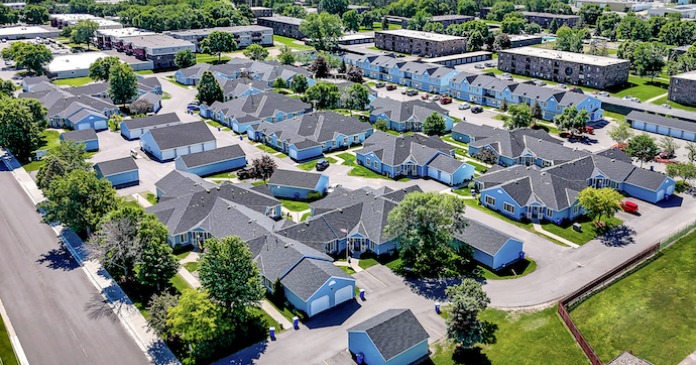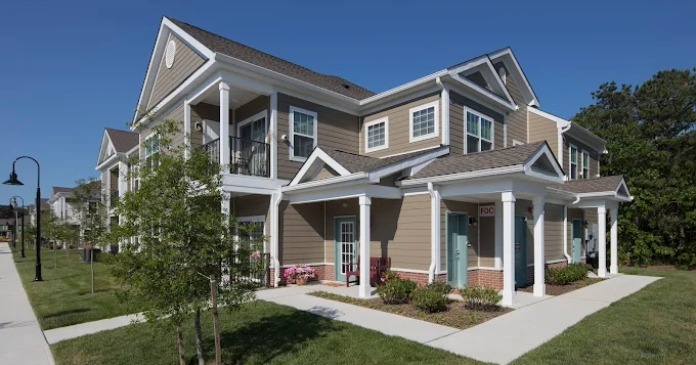Utility costs can take a big bite out of an apartment owner’s bottom line and make up one of a property’s largest expenses. In challenging economic times like these, when owners explore every avenue in the struggle to remain competitive without increasing vacancies, savvy multifamily owners realize that passing on utility costs to residents is key to maintaining strong financial performance.
“We put apartment property utility costs somewhere between 15 and 20 percent of the apartment community operating budget,” said Mike Radice, CEO of NWP Services Corp., a 14-year-old, home-grown company that offers resident utility billing and energy management services to multifamily and commercial real estate owners and operators in 45 states across the nation.
Equity Residential, the nation’s fourth largest apartment owner, with 148,115 units in 552 properties in 23 states and the District of Columbia, has seen annual spikes in utility costs of least 10 percent and more in some markets, said Ed Leigh, VP of Property Operations for the REIT. And rents can’t keep pace with the rising cost of utilities.
But, if handled properly, utility cost recovery, coupled with utility expense management programs from sub-metering companies like NWP and its regional and national competitors can help owners capture revenue that literally is being lost down the drain.
Apartment operators have options to measure and allocate utility costs to individual residents. They include sub-metering apartment homes or through a ratio utility billing system (RUBS)–an allocation formula that divides a community’s utility bills among its residents based on floor space, the number of occupants or some other quantitative measure. And today, “utilities included” apartments are increasingly an anomaly, except when it comes to water, although billing residents for water is a growing trend.
AIMCO VP of Utilities Jeff Bauer looks forward to the day when every state will require water sub-metering on all new apartment construction, paid for by the commodity company. “Electric and gas is almost always sub-metered by the local utility at their expense, depending on the utility, however the owner must build to accommodate the meters. In the future, the same should be applied to the water and sewer so that the apartment owner does not need to bill the residents,” said Bauer. AIMCO has been using ista North America for more than ten years.
RUBS versus meters
Apartment REIT Home Properties owns 33, 334 units across 103 communities located in select Northeast, Mid-Atlantic, Midwest and Southeast Florida markets. Less than 10,000 units are sub-metered and the rest use RUBS. There are benefits unique to both programs, points out Scott Youngman, director of energy management and revenue support for Home Properties, which has subscribed to the services of ista North America for water/sewer, heat and electric billing since 2005.
Sub-metering allows the property manager to bill based on the actual utility company rate, which is then applied to the resident’s actual consumption to calculate the billing. The metered method enables property management to capture 100 percent of the expense incurred for actual consumption in each unit without having to deduct for common-area use.
The RUBS billing method, which can be rolled out quickly since no equipment is necessary, gives the property management the ability to allocate utility costs without any capital investment, and today capital is in short supply. But this method also requires close review to ensure compliance with myriad state and local laws, notes Youngman.
Both methods increase property operating efficiency and add value to the asset. Radice uses water bill-back as an example: “Let’s assume your water savings is $3,000 per month and your cap rate, or borrowing/financing rate, is, say, seven percent. That translates to a value increase of more than $500,000. So reducing operating expenses has a dramatic increase on your property values if you ever want to sell or refinance,” he said.
“From the first time you bill with sub-meters or RUBS, the utility revenue goes right to a community’s bottom line, increasing CNOI,” said Bauer.
Equity Residential subscribes to a Bill Only program with NWP. “Our provider calculates usage, bills the resident and we collect.” said Leigh, adding that the REIT later augmented that program to include NWP’s automated final bill service.
Between 80 and 90 of Equity Residential’s assets are sub-metered, a billing method Leigh believes makes the most sense in areas where water costs are high. “In the places we are developing–on the West Coast and the Northeast–water costs are increasing pretty rapidly,” he said.
“We would rather sub-meter for water than allocate, however, the cost and ongoing maintenance can tend to offset the benefit of having a more detailed recovery system. Obviously many cities and states are getting into regulating and requiring meters, so it makes sense to us to have consistency whenever possible. The critical part to meters is the flexibility for meters to be supported by several platforms and providers,” said Tim Rogers, senior VP of Simpson Housing, an NWP client for nine years.
Most providers offer financing programs to assist with the upfront financial investment needed for a sub-metering program.
AIMCO and Simpson Property Group sometimes retrofit their existing communities, a process that is 40 to 50 percent more expensive than sub-metering a ground-up property.
“The construction of an older community will determine if it is cost effective for an owner to retrofit for sub-meters. An apartment home that has multiple points of entry for water is not a candidate, but a single point of entry into the apartment home is a good candidate for retrofit of sub-meters. However, an owner may need to update lines or equipment to the current building code in order to retrofit for any type of sub-meters. Depending on your ROI requirements, it can take 18 to 36 months to recoup that initial cost,” said Bauer. AIMCO, the nation’s largest REIT and owner of apartments in the nation, with 178,000 units in 44 markets, has rolled out both programs across 92 percent of its conventional portfolio.
Sub-metering systems include the individual sub-meters and the transmitters that gather and transmit meter readings back to the utility biller. Water sub-metering first went mainstream ten years ago and transmitter batteries have a five- to ten-year lifespan. Many of the transmitters in the field today will face the end of their battery life in 2009.
“If your sub-metering system was installed in 2004 or earlier and you have never replaced your transmitter batteries, there is a good chance your transmitter battery is on its last leg,” said ista North America CEO Kernie Brashier. “Once the battery fails, the meter reading will not be transmitted, which means that meter readings cannot be assessed remotely. It’s best to take action before something fails.”
NWP recently introduced an early warning and automatic notification service that monitors customer water and gas meters and automatically notifies them when their meters emit a low battery signal. The new feature is available to customers who utilize Inovonics’ wireless meter reading technology to measure resident water usage.
The green effect
The apartment industry is full of horror stories like the one about the renter who allows the bathtub faucet to run constantly so his pet turtles have running water, or the resident who doesn’t bother to report his leaky toilet to management because he is not billed for the water in his apartment.
Studies suggest that apartment dwellers will conserve utilities when they have to pay for them. “There is a direct correlation between bill back and conservation, and that’s because residents are responsible for their usage,” Radice said.
San Mateo, Calif.-based Prometheus Real Estate Group began to see a change in the habits of its residents when it began rolling out a RUBS program with NWP in 1999 to recoup some of the expenses associated with utilities at its apartment communities.
Cost-saving menu
In addition to traditional utility billing services, a number of sophisticated energy management solutions and invoicing options that can increase operating efficiency and boost community value are now available. These include meter sales and installation to facilitate consumption-based billing, managing and calculating residents’ energy usage and gathering valuable trend information.
NWP’s customer base is divided between two utility receipt methodologies. The lion’s share of the company’s clients subscribe to the allocation service for water allocation only, where the utility companies send property utility bills directly to the apartment community manager, who then routes them to NWP.
“We calculate the utilization over all residents according to their metered or RUBS usage and send a bill to each resident, who may choose from several processes we provide to pay the bill, including online, or e-payment, and check-scanning,” said Radice.
Outsourcing
Apartment owners also may opt to outsource bill processing and payment of local utility bills to a third-party billing service. NWP’s outsource program, UtilityPay Manager, is a service where municipalities/utility companies send the bills directly to Cass Information Systems, Inc., the largest utilities outsourcing company in the U.S. and NWP’s exclusive outsourcing partner in the apartment space.
By connecting electronically to the apartment property’s management software, Cass processes all utility bills for gas, electric, trash, water and sewer, including gas and electric bills for vacant units, pays them and creates a general ledger, before forwarding key data to NWP for consolidation and analysis.
NWP rolled out its outsource program a year ago as part of a re-branding effort and enhanced service package that also includes Resident ePay–a process that enables resident payments to be deposited directly and electronically into the property’s bank account–and Resident OneBill, a convergent (utilities and rent) billing solution that enables property owners to include all resident property charges on one itemized bill.
Vista North America’s outsource program is Utility Expense Management.
A major benefit of third-party billing is that it eliminates a level of complexity at the property level. “The paper storm goes away and the accounts payable costs go away,” said Radice. “People who do studies on accounts payable would probably tell you the cost to process a bill is anywhere between $9 and $17. We take that cost to sub $3, so there is an incredible savings.”
In 2005, Prometheus expanded its utility billing program to include UtilityPay Manager, motivated by the cost of paying for electricity in vacant units and the extremely short billing cycles of some utility companies.
“We found it difficult to pay in a timely manner within the windows the municipalities had given us. Cass is just a lot faster at getting those bills transmitted,” said Mary Nitschke, Prometheus operations and special projects manager.
The program has saved Prometheus thousand of dollars in late fees, staff hours spent calling utility companies for extensions or to have late fees waived and time spent driving utility checks to municipalities to avoid late-payment penalties.
“Our staff spent a considerable amount of time paying these bills, so in addition to increasing our revenue, we decreased our vacant electric by thousands of dollars and decreased our late fees and our depository requirements. It’s been a win, win, win for us,” said Nitschke.
Regulatory watchdog services are another valuable function provided by third-party billing companies and quality regulatory support and review is critical to a successful program. The regulatory team will review and audit rate schedules to ensure that the municipality is billing the property owner correctly and under the proper plan.
“This past year, Cass saved us approximately $6,000. The utility company was just using the wrong rate schedule for the property and calculating the fees incorrectly. So there’s a cherry on top of a very delicious sundae,” Nitschke said.
AIMCO has elected to reallocate any commodity that is master-metered by a utility provider at a given community, wherever legally possible. “What makes Vista such a great utility billing partner is that Vista has a regulatory group that determines which commodities at a community can be billed and how that commodity can be billed to the resident,” said Bauer.
Vacant recovery
Vacant unit utility consumption and utility theft can be huge drains on an owner’s finances. When it comes to electricity and gas, the costs ultimately are the responsibility of the owner under a continuing service agreement, or CSA. When a resident moves from a unit, the utility company doesn’t shut off the utility service. Instead, the meter automatically is switched back into the owner’s name, without any notice to the owner. And, it is the responsibility of a new renter to switch the utilities into their name.
Although it is the policy of most apartment managers not to release the keys to a new resident until they provide a utility account set up with their name on it, that doesn’t always happen, said Radice. Identifying and recovering costs that should be, but aren’t, billed to the resident are added benefits of utility pay management programs.
For NWP, vacant recovery works like this: When NWP receives billing and payment information from Cass, NWP loads that information into a database that electronically compares vacant unit utility invoices. If a resident moved mid-month and Cass received an electric bill for that unit on behalf of the property owner through month-end, NWP’s database would detect the lag time between the resident move-in date and the time the bill was converted to the resident’s name. It works similarly for move-outs, where the residents who have given notice change the utility back to the property owner’s name, sometimes weeks before leaving the community.
Once the name, address and exact amount of the billing discrepancy for any resident who did not immediately transfer utility service into their name upon move-in is determined, NWP bills that resident for the portion they owe. “This process has enabled NWP to identify millions of dollars a year for our energy management clients,” said Radice.
“Sometimes you’ll have a resident move in and put off changing the utility into their name, saying, ‘I’ll just take care of that next month,’ and that really impacts your property’s bottom line and can triple your vacant electric expense. So it’s a great motivator for those residents to actually see those expenses on their NWP bill. I think it prompts them,” said Nitschke.
One bill pays all
Convergent billing, or including all utilities and rent on one bill, has been available for four or five years. Associated Estates Realty Corp, an apartment REIT headquartered in Richmond Heights, Ohio, subscribes to the full range of NWP’s products. The company was one of the first to roll out NWP’s convergent billing program across it 13,192-unit portfolio.
“The primary drivers for implementing the program were to decrease late fees and increase internal efficiencies,” said Associated Estates Director of Ancillary Services Tim Haddon, adding that it just made sense to put all resident charges on a single bill they receive every month. “When rent and utilities are on the same bill, it simplifies the payment process for the resident,” he continued.
Radice points out that, “There are some residents who will pay their rent, but not their utility bill, or claim they didn’t get a utility bill. So, when it’s all on one bill, the likelihood of that goes away. And, importantly–and this is a nuance of the industry–when you put rent and utilities on the same bill, you can apply the amount you receive against that bill first to utilities. That way, if the resident comes up short you have the leverage of eviction because they have not paid their full rent. When rent and utilities are on separate bills, you don’t have that option.”
Green bill
New services from NWP include security deposit payment processing, final bill notification and a billing preview report that will be extremely helpful to customers rolling out utility billing for the first time.
Green billing is the next frontier. NWP recently introduced a service where everything is done electronically. “All bills come to us electronically from the utility company, we compute them electronically and send out an electronic e-bill and the resident makes an electronic payment. There is no paper, so no trees die,” said Radice.
The convergent billing model also helps companies to be a bit greener because it greatly decreases the number of bills sent and checks they receive.
















